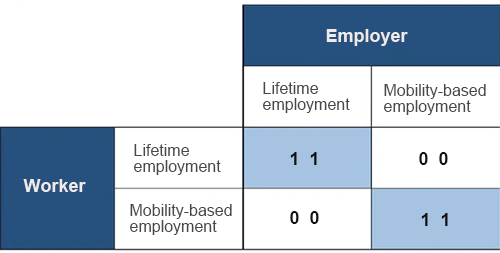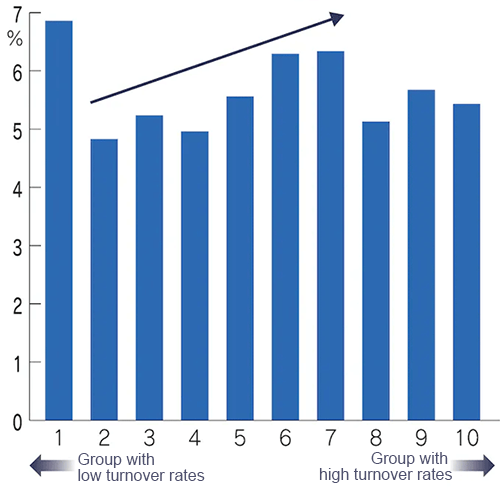Many people argue that increasing labor market mobility is important as the key for a growth strategy and structural reform, and this is also picked up periodically as a theme in the national government's labor market reform. In Japan today, should labor market mobility be increased?
First of all, why does labor market mobility vary by country or by era? When comparing Japan and the United States, mobility in the US labor market is recognized as being higher, but labor market mobility was also high in prewar Japan.
In comparative institutional analysis, which is one field of economics, an institution is recognized as a game theoretic equilibrium and it is interpreted that interactions between behavioral patterns and mechanisms of diverse economic entities, and institutional complementarity affect the creation of both an equilibrium with high mobility and an equilibrium with low mobility in the labor market.
◆◆◆
Let us consider using a simple game-theoretic framework. The players are a worker and an employer, and each selects either a lifetime employment strategy or a mobility-based employment strategy.
Regarding the worker, in a lifetime employment strategy, a worker endeavors to work for the same company basically until retirement, while in a mobility-based employment strategy, a worker changes jobs if unhappy with the company or if there is another company with better working conditions.
Regarding the employer, in a lifetime employment strategy, an employer maintains the employment and develops the skills of workers on the premise that workers will work for the company until retirement, rarely hires mid-career workers and refrains from dismissing workers. In a mobility-based employment strategy, an employer manages employment on the premise that workers may change jobs, positively hires mid-career workers without developing the skills of workers and dismisses workers as necessary.
Considering that a worker and an employer cannot both benefit unless their strategies match (Figure 1), there are two types of equilibria that are combinations of best-response strategies which take the counterparty's strategy as a given (the Nash equilibrium): an equilibrium with low mobility where both select lifetime employment and an equilibrium with high mobility where both select mobility-based employment.


Which equilibrium broadly prevails nationwide and becomes a shared prediction model is determined based on time- and place-dependent historical developments, which are beyond the framework of game theory.
Both an equilibrium with low mobility and an equilibrium with high mobility are reasonable as a behavioral pattern and framework of an economic entity as long as the equilibrium is maintained. However, which equilibrium creates higher performance in the economy overall is a different question. Which equilibrium is preferable may vary depending on the economic environment of the time, and a hundred-and-eighty-degree shift may occur if the economic environment itself changes significantly.
What about mobility in employment at the corporate level? This will naturally be subject to labor market mobility at the national level, but theoretically, there may be an adequate level of mobility in employment that enables each company to maximize profits. If there is an optimal level of employment mobility, the business performance of individual companies will deteriorate if their current levels are lower or higher than that level. In other words, it is assumed that there is an inverted U-shaped relationship between mobility in employment and business performance at a corporate level.
Using Japanese corporate data, a paper authored in 2016 by Keio University Professor Isamu Yamamoto found an inverted U-shaped relationship wherein higher mobility in employment (turnover rate and excess in mid-career hiring rate) increases ROS, but when mobility becomes excessive, profit rate declines. Additionally, the Annual Report on the Japanese Economy and Public Finance for 2018, which uses different corporate data, showed that there is an inverted U-shaped relationship between the turnover rate and the ratio of value added.
Also, according to the recent analysis by Gakushuin University Professor Miho Takizawa and myself, using the Nikkei Smart Work Management Survey (annual survey) that covers over 800 listed companies, an inverted U-shaped relationship was confirmed between mobility in terms of the turnover rate at a corporate level and business performance of companies in terms of ROS, with the same results as those in the aforementioned analysis.
However, in our analysis, the turnover rate that marks the beginning of an inverted U-shaped relationship was very high and a positive relationship was found between the turnover rate and the ROS for most of the analyzed companies. This can be observed from Figure 2 which shows median ROS for each group of companies based on turnover rate levels.
An equilibrium with low mobility has been maintained in the labor market overall in Japan, however our findings suggest that although companies should normally pursue higher labor mobility, such selection may be hampered.
◆◆◆
Additionally, one reason that labor market mobility often comes up in making policies is that it is expected to have a labor reallocation effect. In short, this is the supposition that mobility of workers from less productive to more productive sectors will increase the productivity of the economy as a whole.
For example, the movement of surplus workers from less productive agricultural sectors to highly productive industrial sectors accelerates the productivity increase and growth of the entire economy, and this phenomenon was notable during Japan’s period of high economic growth and during the same phases in Asian countries.
However, a paper by the Bank of Japan in 2022 clearly states that the effect of labor reallocation among industries in Japan has become smaller, especially since the 2000s.
Is it always efficient to reallocate resources from less productive sectors to highly productive sectors? Hitotsubashi University Professor Etsuko Shoji cites two counterexamples.
One is a case in which the improvement of productivity in manufacturing industries increases income, which brings about relative increases in the demand for and prices in service industries with high income elasticity, resulting in a situation where it is considered more efficient if resources are allocated to service industries. Another is a case in which for a sector in a manufacturing industry where continuous productivity increase is prominent (the electrical machinery sector), relative price reductions due to cost reductions become more notable and it instead becomes preferable to remove resources from that sector.
According to the analysis through international comparisons of changes in the number of workers and labor productivity by industry in the 2010s in the 2021 White Paper on the Labor Economy, patterns within Japanese industry have become polarized into the pattern of various services industries (including the information and communications industry) in which the number of workers is increasing and the productivity remains unchanged, and the pattern of the manufacturing industry in which the number of workers is decreasing and the productivity is increasing. This suggests the possibility that the aforementioned examples have become a reality.
In other words, workers are moving from the manufacturing industry in which the productivity level is high and productivity is increasing rapidly to the service industries in which the productivity level is low and productivity increase is slow, and such labor mobility does not necessarily promote growth of the entire economy. On the other hand, in the United States, increases in the number of workers and in productivity are observed in many industries and the effect of labor reallocation seems to be larger.
Smooth labor mobility into growing fields is an ideal but is not necessarily easy and often ends up being a fantasy. In Japan, we would like to start with tearing down the conventional practice of membership-based employment on the premise of no labor mobility, which is often seen in large, listed companies. Our hope is that the spread of job-specific employment (with limited role responsibility), which encourages desirable career changes by guaranteeing individual regular workers' career autonomy, will help achieve labor mobility that is also desirable for companies.
* Translated by RIETI.
May 16, 2023 Nihon Keizai Shimbun


